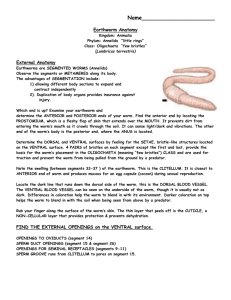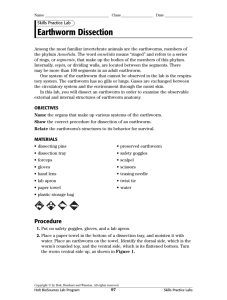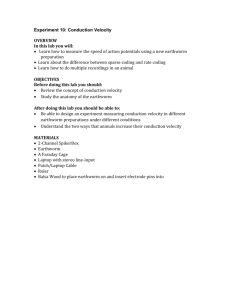File
advertisement
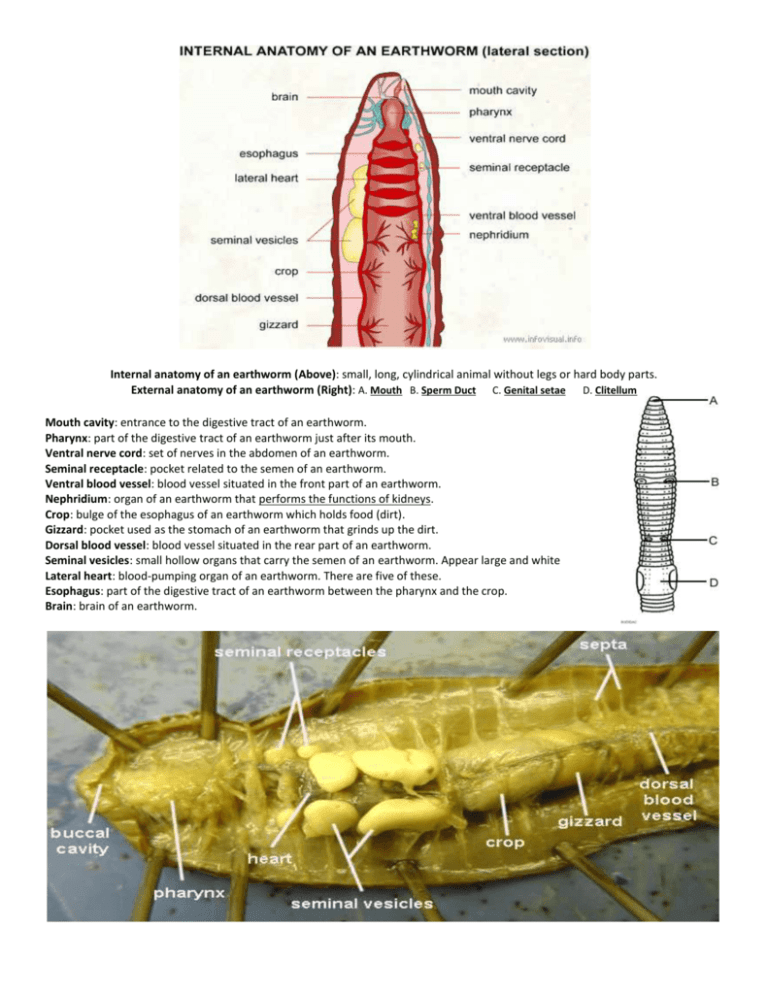
Internal anatomy of an earthworm (Above): small, long, cylindrical animal without legs or hard body parts. External anatomy of an earthworm (Right): A. Mouth B. Sperm Duct C. Genital setae D. Clitellum Mouth cavity: entrance to the digestive tract of an earthworm. Pharynx: part of the digestive tract of an earthworm just after its mouth. Ventral nerve cord: set of nerves in the abdomen of an earthworm. Seminal receptacle: pocket related to the semen of an earthworm. Ventral blood vessel: blood vessel situated in the front part of an earthworm. Nephridium: organ of an earthworm that performs the functions of kidneys. Crop: bulge of the esophagus of an earthworm which holds food (dirt). Gizzard: pocket used as the stomach of an earthworm that grinds up the dirt. Dorsal blood vessel: blood vessel situated in the rear part of an earthworm. Seminal vesicles: small hollow organs that carry the semen of an earthworm. Appear large and white Lateral heart: blood-pumping organ of an earthworm. There are five of these. Esophagus: part of the digestive tract of an earthworm between the pharynx and the crop. Brain: brain of an earthworm. Earthworm Anatomy External Anatomy 1. Examine your earthworm and determine the dorsal and ventral sides. Locate the two openings on the ventral surface of the earthworm. 2. The openings toward the anterior of the worm are the sperm ducts. The openings near the clitellum are the genital setae. 3. Locate the dark line that runs down the dorsal side of the worm, this is the dorsal blood vessel. The ventral blood vessel can be seen on the underside of the worm, though it is usually not as dark. 4. Locate the worm's mouth and anus. 5. Note the swelling of the earthworm near its anterior side - this is the clitellum. Internal Anatomy 1. Place the specimen in the dissecting pan DORSAL side up 2. Locate the clitellum and insert the tip of the scissors about 3 cm posterior. 3. Cut carefully all the way up to the head. Try to keep the scissors pointed up, and only cut through the skin. 4. Spread the skin of the worm out, use a teasing needle to gently tear the septa (little thread like structures that hold the skin to organs below it) 5. Place pins in the skin to hold it apart – set them at an angle so they aren’t in the way of your view. Reproductive System The first structures you probably see are the seminal vesicles. They are cream colored and located toward the anterior of the worm. These are used for producing sperm. Use tweezers to remove these white structures from over the top of the digestive system that lies underneath it. Check the box when this is complete. Circulatory system The dorsal blood vessel appears as a dark brownish-red vessel running along the intestine. The heart (or aortic arches) can be found over the esophagus (just posterior to the pharynx). Carefully tease away the tissues to expose the arches of the heart. How many aortic arches can you count? _______________ Digestive System The digestive system starts at the mouth. You will trace the organs all the way to the anus and identify each on the worm. Find the mouth opening, the first part after the mouth is the pharynx, you will see stringy things attached to either side of the pharynx (pharyngeal muscles). The esophagus leads from the pharynx but you probably won’t be able to see it, since it lies underneath the heart. You will find two structures close to the clitellum. First in the order is the crop, followed by the gizzard. The gizzard leads to the intestine, which is as long as the worm and ends at the anus. Use your scissors to cut open the crop and the gizzard. Which one has the harder exterior? _______________ Place in the correct order (number) _______ Anus _______ Crop _______ Mouth _______ Gizzard _______ Esophagus _______ Intestine _______ Pharynx Nervous System Locate the brain in the far anterior region of the worm. It is very very tiny and whitish colored. If you can’t find it, it is probably because it was destroyed when you cut the worm. You CAN locate the ventral nerve cord by removing the intestines and searching for the white string-like structure that runs the length of the worm. Remove the intestine and locate the ventral nerve cord. Check the box when this is complete. Lab Analysis (answer True or False) 1. ____ The brain attaches to the ventral nerve cord. 2. ____ The dorsal side of the worm is lighter than the ventral side.. 3. ____ The clitellum is located toward the anterior end of the worm. 4. ____ The esophagus lies beneath the pharynx 5. ____ Earthworms are hermaphrodites. 6. ____ The ventral nerve cord and the ventral blood vessel are connected. 7. ____ The pale string-like structure running the length of the ventral side of the worm is the blood vessel. 8. ____ An earthworm has fourteen aortic arches. 9. ____ The dorsal blood vessel can be seen from the worm’s exterior. 10. ____ Seminal vesicles are part of the worm’s digestive system. Label the image.
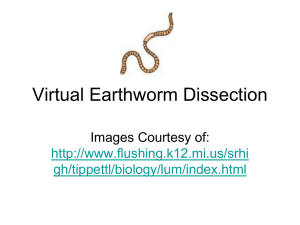
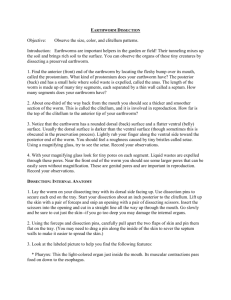

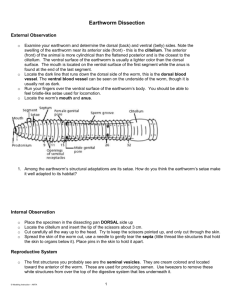
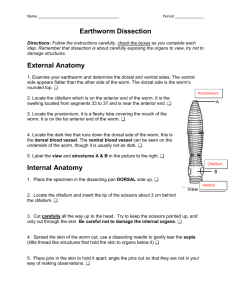
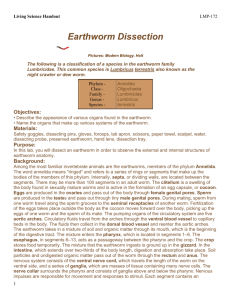
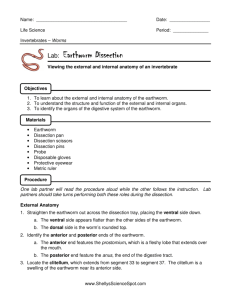
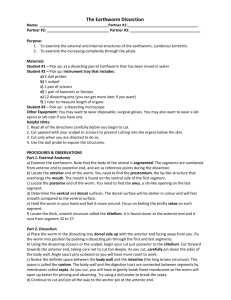
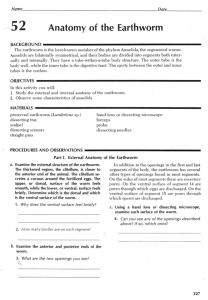
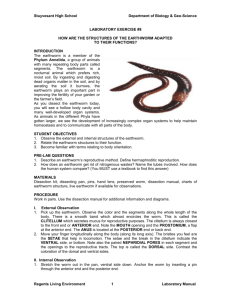
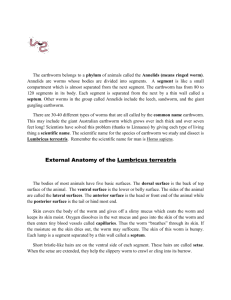
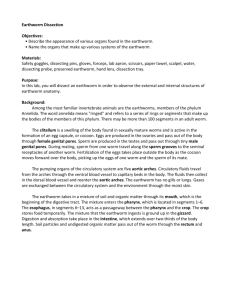

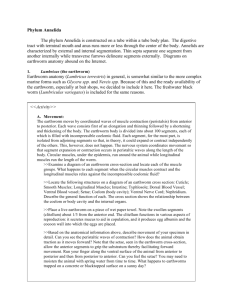
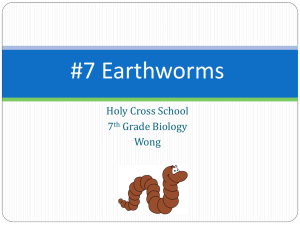
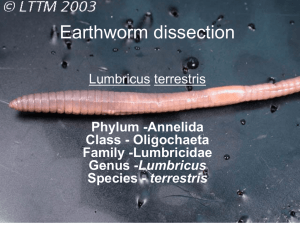
![Earthworm Lab [1/16/2014]](http://s3.studylib.net/store/data/007071636_1-f0a789e538fb90aecda95ecf7b0a3557-300x300.png)

